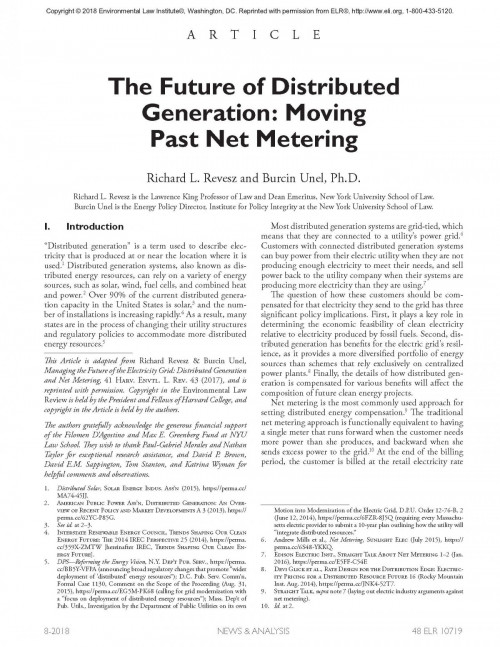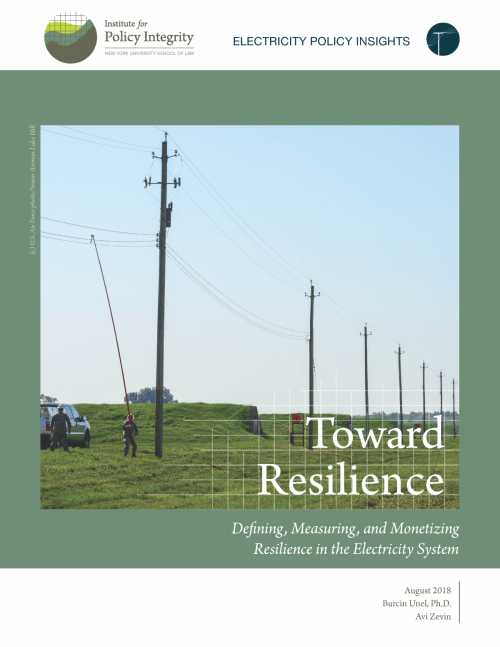-
Policy Integrity Input Leads to Climate Progress in Nevada
Input from the Institute for Policy Integrity helped encourage Nevada to modernize its energy policymaking by accounting for the impacts of carbon pollution in key electric utility planning decisions. At the recommendation of Policy Integrity and partner groups, the Public Utilities Commission of Nevada recently included language on the Obama-era Interagency Work Group’s Social Cost of Carbon (SCC) in new rules governing utilities’ resource plans.Utilities will now have to analyze and clearly disclose the damages caused by climate change when evaluating alternative long-term resource plans. This information will be used by utilities and the Commission when selecting their preferred resource plan.
-

The Future of Distributed Generation
Moving Past Net Metering
This article provides an overview of the benefits and the costs of distributed generation and highlights the analytical flaws and missing elements in the competing positions and in most existing policies. We propose an alternative approach that recognizes the contributions to the electric grid of both utilities and distributed generators. The article is excerpted and revised from a longer academic article, “Managing the Future of the Electricity Grid: Distributed Generation and Net Metering,” which was selected by Environmental Law Reporter as one of the five best environmental law articles published in the 2017-2018 academic year.
-

Toward Resilience
Defining, Measuring, and Monetizing Resilience in the Electricity System
Grid resilience—generally, the electric grid’s ability to resist/absorb, manage, quickly respond, and recover from/adapt to high-impact, low-probability external shocks—has been a concern for electric utilities and energy planners for decades. While recent extreme weather and cyber security concerns have prompted the federal government to pursue policies that support coal and nuclear power plants, a more systematic focus on resilience will lead to very different solutions than what has been proposed by the Department of Energy. Our report aims to assist policymakers in understanding grid resilience and evaluating potential interventions aimed at improving grid resilience.
-
Comments to the Nevada PUC on the Proposed Regulation to Implement SB 65
The Nevada Public Utilities Commission recently released a proposed regulation to implement Senate Bill 65, which directs the PUC to give preference to those measures and sources of supply that provide the greatest economic and environmental benefit to the State. In our joint comments with Western Resource Advocates and Environmental Defense Fund, we express our support for these revisions to Nevada’s resource planning regulations. Specifically, we support the Commission’s application of the Interagency Working Group (IWG) Social Cost of Carbon (SCC) estimates to calculate the Present Worth of Societal Costs in Nevada, as reflected in the proposed regulation. In addition, we update the PUC on the use of the IWG SCC estimates in other states, including California, Colorado, Minnesota, New York and Washington State.
-
Comments on FERC’s NOI on the Certification of Interstate Natural Gas Pipeline Facilities
In April 2018, the Federal Energy Regulatory Commission (FERC) issued a notice of inquiry on how to revise its policy on certifying the construction and operation of interstate natural gas transportation facilities. In the nineteen years since FERC’s existing policy statement was released, there have been significant advances in the understanding and measurement of climate change and other environmental effects of natural gas production, transportation, and consumption. Our comments suggest clarifications and improvements to FERC’s NEPA and Natural Gas Act analyses that will better inform policymakers and the public about the environmental effects of proposed projects. We also submitted joint comments on the appropriate use of the social cost of carbon in the interstate natural gas facilities certification processes, including why and how greenhouse gas emissions should be monetized in FERC’s NEPA and Natural Gas Act analyses.
-

How States Can Value Pollution Reductions from Distributed Energy Resources
DERs are a growing part of the U.S. electric system and many state electric utility regulators are looking to more accurately compensate them by paying for a variety of the benefits that these resources provide. Most states are currently focusing on energy and distribution-level benefits, but this approach overlooks the environmental and public health impacts of DERs. Even though some states like California and New York have been working on analyses that include environmental attributes of DERs, few regulators have attempted a thorough evaluation of the environmental and public health benefits. Our report, Valuing Pollution Reduction, lays out a practical methodology for calculating the E value, the highlights of which are captured here. Specifically, this issue brief describes how to appropriately value environmental and public health benefits by monetizing the economic, health, and climate damages avoided emissions would have caused. State utility regulators can use the steps described here, weighing tradeoffs between accuracy and administrability, to implement their own program to holistically compensate DERs.
-
Comments to FERC on Seasonal Capacity Markets and Electricity Demand
PJM Interconnection (PJM), the electric grid and wholesale market operator in 13 states and Washington D.C., currently has a market design that leads to over-procurement of electric generating capacity, particularly from generation resources that are able to provide capacity throughout the year. This inefficient market design raises capacity costs and suppresses the participation of resources, such as wind, solar, and natural gas, whose generating capacity varies by season. The Federal Energy Regulatory Commission (FERC) recently held a technical conference to seek feedback on how PJM can redesign its capacity market to better facilitate participation of these seasonal resources. Our comments to FERC argue that replacing or supplementing the current annual-only capacity product with seasonal capacity products would improve the efficiency of the PJM capacity market. In addition, we suggest changes in the capacity market participation rules for wind, solar, and other intermittent resources.
-
Environmental Value of Distributed Energy Resources for New York State - Subgroup Report
New York State is seeking to refine its method for compensating distributed energy resources (DERs) based on the value that they provide, including their potential to reduce local air pollution and greenhouse gas emissions. Together with a group of government agencies, non-governmental community and environmental organizations, academic centers, and clean energy businesses, we submitted a report that describes the work of an informal, stakeholder-led Environmental / Environmental Justice Value Subgroup, which was formed to identify methods for calculating the environmental and public health value of avoided air pollution caused by DER injections in New York State. As part of that filing, we also submitted our report, Valuing Pollution Reductions, which serves as a general guide for state regulators interested in calculating the environmental and public health value of avoided air pollution caused by DER injections.We also presented the results of this report to NYS DPS Staff.
-
Comments to New York on Electricity Rate Design
New York State is in the process of reforming its payment system for distributed energy resources (DERs), such as rooftop solar panels, away from a net energy metering policy that compensated these resources at retail electricity rates. Our comments to the New York Public Service Commission encourage the state to move towards rate designs that better reflect the underlying costs of generating, transmitting, and distributing electricity, including environmental externalities for all customers, including those who do not own DERs. Our joint comments with other stakeholders also offer high-level principles for rate design that can help achieve the state’s clean energy goals.
-
Comments to FERC on Electric Grid Resilience Order
The Federal Energy Regulatory Commission (FERC) requested feedback from regional electricity regulators on the state of resilience in wholesale markets, efforts underway to ensure grid resilience, and opportunities for future improvement. Their responses make clear that while grid resilience is an issue worthy of continued attention, there is not currently evidence to support mandatory, national or even regional action to address acute resilience concerns. Our comments to FERC argue that it should not seek a “one-size-fits-all” solution for all Regional Transmission Organizations and Independent System Operators (RTOs/ISOs), nor should it consider resilience a “catch-all” concept that opens the door to otherwise unsupported or unnecessary actions.
Viewing recent projects in Electricity



